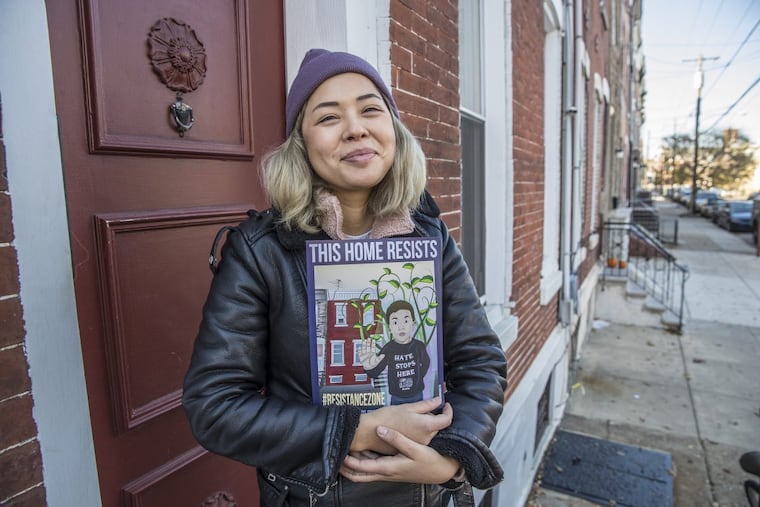What's behind that boy you see in South Philly windows
The posters train people how to protect their rights and those of their neighbors, should they be approached by local police or agents from federal Immigration and Customs Enforcement, known as ICE.

Erika Guadalupe Núñez dwells at the intersection of art and resistance.
So when the activist group Juntos needed a bold image to inspire neighborhood solidarity amid unnerving immigration raids — federal authorities snatched 107 people in a single September sweep — it turned to her.
The result: a full-color placard for households to display in their front windows, alerting all, "This home resists." It anchors a "community resistance zone" that Juntos has launched across a large swath of South Philadelphia.
One side of the poster shows a young Latin boy standing in front of a brick rowhouse, his hand raised as if to say, "Stop." On the back, in English and Spanish, is a list of "Do's and Don'ts" if immigration agents or police come pounding on the door.
Tip No. 1: Don't open the door.
"It speaks across languages," said Núñez, 26. "It's community members saying, 'We have to start looking out for one another.'"
She enveloped the poster boy with an elliptical, blue background, as a way to make him more prominent. But others see the sacred, an outline similar to the aureole that surrounds the Aztec goddess Tonantzin or the Virgin of Guadalupe.
Núñez swears that was unintentional.
Whether secular or religious, that art now hangs in an outsized gallery: The windows and doors of shops and homes from Third Street west to Ninth Street, and Washington Avenue south to Oregon Avenue.
There Juntos has created its first "resistance zone," a block-by-block effort to oppose the Trump administration's tough stance on immigration and undocumented immigrants. During one weekend this month, Juntos' volunteers knocked on 3,000 doors, handing out posters as they went.
They trained people how to protect their rights and those of their neighbors, should they be approached by local police or agents from federal Immigration and Customs Enforcement, known as ICE.
"It was really important to have something you put up in your window, so that when they're at your door, and they might be banging on the door, that you're reminded of your rights," said Juntos Executive Director Erika Almiron. "It was important for community members to see these posters in the windows and know our neighbors and friends have committed to be our allies."
By using posters to spread awareness, Juntos draws on a rich history of protest art, of drawings and prints that aim to coax people into movements by engaging their emotions and intellect. The best endure forever:
The plain and powerful signs — "I am a man" — carried by striking Memphis sanitation workers in 1968. The dainty flower in the Vietnam-era poster, "War is not healthy for children and other living things." Or, more recently, the Women's March image of a woman wearing a red, white and blue hijab.
"People need to see something in order to be able to respond," said Christian Frock, a California arts writer and educator who recently curated, Take This Hammer: Art + Media Activism from the Bay Area. "Empathy is the driving mechanism of a response."
Núñez was born in Mexico and lived in Phoenix and Chicago before coming to Philadelphia. She graduated with a degree in fine arts from Bryn Mawr College in 2013, and now works as manager of community programs at the Fleisher Art Memorial.
She lives in South Philadelphia, but her true home, she said, is at Juntos, where she volunteers, serves on the board, and most important, works as what might be called the artist in residence.
If you notice an especially affecting banner carried at the front of a Juntos march, one that makes people call out in praise or dismay, Núñez probably created it.
She was 10 when she came to the United States, traveling with her mother on a
dangerous three-day trek through the desert. Her father was already here.
None had legal permission to be in the country. All have it now.
They came, Núñez said, to escape desperate poverty. When she was a baby, her mother so lacked food and nutrition that she could not produce breast milk. Her parents wanted her to have a better life.
Núñez' drive and intelligence stood out at Waukegan High School in Illinois. Her father hoped she would go into medicine. But a cringing dissection of a pig in college put an end to that plan. And besides, art was calling.
For the poster, Núñez recruited a young friend as a model. The rowhouse of a colleague supplied the background. It's the familiar Philadelphia setting, and the boy, in all his vulnerability, that touches our common humanity, she said.
"I'm hoping that when folks see it they feel empowered to take action to fight against hate in all of its various forms," Núñez said. "I hope the poster reminds folks that they are the greatest defenders of their community."